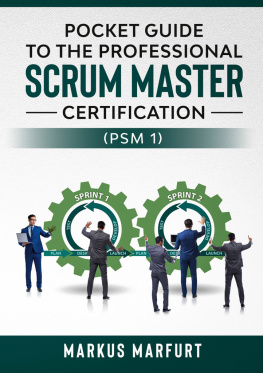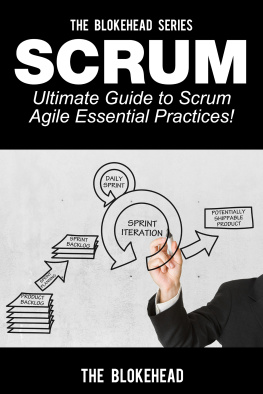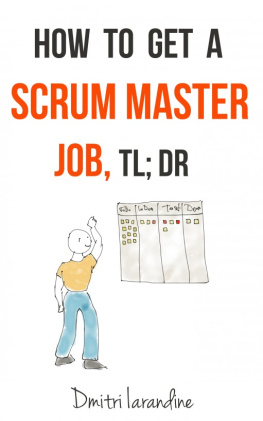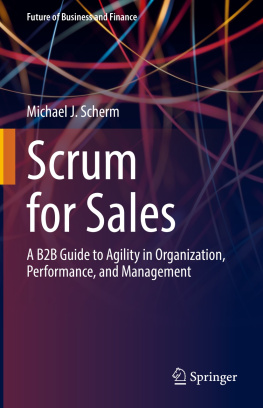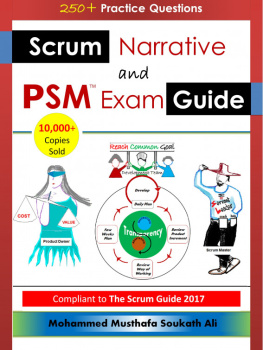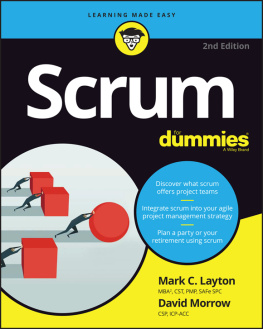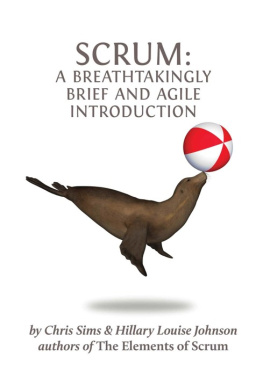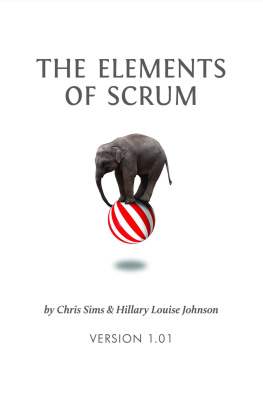Yitmen - SCRUM: A Story of Transformation: A Go-To Guide To Start Your Agile Journey
Here you can read online Yitmen - SCRUM: A Story of Transformation: A Go-To Guide To Start Your Agile Journey full text of the book (entire story) in english for free. Download pdf and epub, get meaning, cover and reviews about this ebook. year: 2020, genre: Business. Description of the work, (preface) as well as reviews are available. Best literature library LitArk.com created for fans of good reading and offers a wide selection of genres:
Romance novel
Science fiction
Adventure
Detective
Science
History
Home and family
Prose
Art
Politics
Computer
Non-fiction
Religion
Business
Children
Humor
Choose a favorite category and find really read worthwhile books. Enjoy immersion in the world of imagination, feel the emotions of the characters or learn something new for yourself, make an fascinating discovery.

SCRUM: A Story of Transformation: A Go-To Guide To Start Your Agile Journey: summary, description and annotation
We offer to read an annotation, description, summary or preface (depends on what the author of the book "SCRUM: A Story of Transformation: A Go-To Guide To Start Your Agile Journey" wrote himself). If you haven't found the necessary information about the book — write in the comments, we will try to find it.
Yitmen: author's other books
Who wrote SCRUM: A Story of Transformation: A Go-To Guide To Start Your Agile Journey? Find out the surname, the name of the author of the book and a list of all author's works by series.
SCRUM: A Story of Transformation: A Go-To Guide To Start Your Agile Journey — read online for free the complete book (whole text) full work
Below is the text of the book, divided by pages. System saving the place of the last page read, allows you to conveniently read the book "SCRUM: A Story of Transformation: A Go-To Guide To Start Your Agile Journey" online for free, without having to search again every time where you left off. Put a bookmark, and you can go to the page where you finished reading at any time.
Font size:
Interval:
Bookmark:
Mehmet Yitmen
Thanks to Ken Schwaber, Dave West, James Coplien, Gunther Verheyen, Tolga Kombak, Jrn Kolodzey, and all the friends, teams, and organizations that inspired me!
Thanks to Omer, Seb, and Natasha for their great efforts in translating the book into English!
I would also like to offer my gratitude and respect to Ken Schwaber and Jeff Sutherland, for gifting us with Scrum.
Omer, Seb, & Natasha
Wed like to thank Mehmet for contributing his work to this project, even when the promise looked unlikely to be realized.
The characters and events portrayed in this book are fictitious. Any similarity to real persons, living or dead, is coincidental and not intended by the author.
No part of this book may be reproduced, or stored in a retrieval system, or transmitted in any form or by any means, electronic, mechanical, photocopying, recording, or otherwise, without express written permission of the publisher.
Cover design by: zgr Tellal
In this book, Mehmet narrates the story of a Scrum transformation through the eyes of Hakan, a Scrum Master and change agent. By telling the story from Hakans point of view, he makes the challenges of transformation feel both real and personal. The journey that Hakan takes is a journey that we all face when introducing agility. First, there is the realization that the challenges he sees every day can be removed. Then sharing these ideas with others and getting support. The pilot project comes next, followed by learning and improvement. Finally the destination of enterprise adoption. Only when you get to that destination do you realize that actually the journey can continue and you are never done. Throughout the narrative, Mehmet introduces practical guidance and patterns that readers can employ in their specific circumstances.
The story of Hakan may not be everyones story, but I am sure there are moments in the narrative where the reader will think, Ha, that happened to me, and I wish I had done X. Such moments make this book not only more accessible, but also an opportunity for reflection.
Adopting Scrum is not easy, but it can be successful and can go from one team to many. It can change organizations allowing them to be responsive and humane. It can deliver innovation and business success, but it can only do this if people implement the ideas. Scrum requires people, and this is a story about people. Too often we forget that when talking frameworks, patterns, and practices. People are what make Scrum a success or failure and this book provides a great story about the people involved.
Thank you, Mehmet, for sharing this story. and I hope others enjoy it. Scrum On!
Dave West, CEO Scrum.org
Now imagine introducing Scrum as a different way of working. Imagine the courage it takes, as well as the excitement that it can lead to. Can you do that, imagine Scrum working in your organization? The changes that would bring about? The friction that might cause?
Mehmet Yitmen is an experienced consultant and Scrum practitioner, and he has been there. Mehmet has combined and made available his insights and experience for you as a fiction story; a transformation tale. Although the company is fictitious, the story is highly recognizable.
Mehmet describes what you might subsequently go through and how that feels during the process of implementing Scrum: the steps, discoveries, difficulties, the pleasures and the pains. He shines a light on what you might encounter on your path before and after introducing Scrum, and how to possibly respond to that; from acknowledging problems with your existing processes, to selecting a pilot project, to the different responses you might encounter, to the changes needed in culture and mindset.
Mehmet shares a tale that can help you envision a new future for you and your organization, a future where you will feel fitter and better placed to deal with unpredictability and change. Mehmet helps you the way to quickly embark on what will be a continual journey. Because, adopting Scrum is more than just a one-time effort of introducing Scrum; it is a continual exercise of thinking, rethinking, and discovery. That, in the end, is the organizational state called agility that we hope to achieve by introducing Scrum.
Gunther Verheyen, Independent Scrum Caretaker
This is the kind of question frequently asked of me over the last decade. Whether as a speaker at conferences and seminars, a trainer, or an enterprise agile coach, its clear that there has never been a broader or deeper interest in Scrum.
Whether the question comes from a beginning developer or an experienced business leader, there is no single, universally applicable response.
During the course of my agility consulting practice, Ive worked closely with numerous companies and have coached hundreds of teams. In every company I have supported, each individual team has required a different approach to fit their specific needs.
Ultimately, Scrum is a fundamental project of change for most teams or organizations; therefore, each journey needs to be custom tailored. Scrum applies a unique mechanism and perspective, so when considering how best to apply Scrum, critical examples from my own experiences of introducing it seem not only pertinent, but crucial to illustrating good practice.
People express a great deal of curiosity about how others have implemented such change within their own teams and companies. Using examples of real experiences can help to illustrate this process. Each unique setting invites unpredictability, so it is important for each organization to first understand its own dynamics before implementing Scrum. Nevertheless, some scenarios or issues are fairly universal.
While there are dozens of books and resources in the industry about Scrum, there are few sources of guidance on how to implement it using real-life situations encountered during the implementation process. With this in mind, I set out to respond to this deficiency by sharing my own experience in order to offer guidance for those looking to apply Scrum.
I have tried to convey the process of introducing a fictitious company to Scrum, presenting the process of change in a simple, narrative form. The fictitious company I refer to struggled with constant delays in software projects and experienced difficulty in managing change. In addition, the employees were dissatisfied with the results of the projects, and the IT department lacked motivation.
In order to make the book both memorable and easy to read, I use the form of a narrative, told from the perspective of a Scrum Master, an important role in Scrum. As an initiator and leader of change, I illustrate the challenges faced by the Scrum Master, while highlighting important Scrum concepts.
Font size:
Interval:
Bookmark:
Similar books «SCRUM: A Story of Transformation: A Go-To Guide To Start Your Agile Journey»
Look at similar books to SCRUM: A Story of Transformation: A Go-To Guide To Start Your Agile Journey. We have selected literature similar in name and meaning in the hope of providing readers with more options to find new, interesting, not yet read works.
Discussion, reviews of the book SCRUM: A Story of Transformation: A Go-To Guide To Start Your Agile Journey and just readers' own opinions. Leave your comments, write what you think about the work, its meaning or the main characters. Specify what exactly you liked and what you didn't like, and why you think so.

